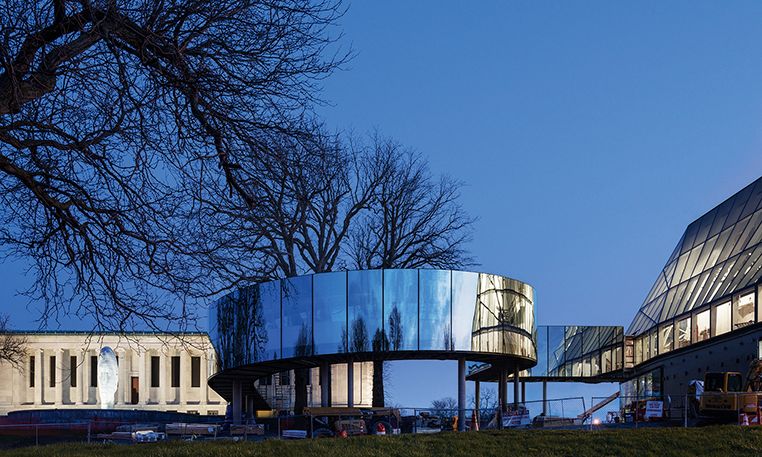A curved, glass-walled bridge connects new and old buildings at the expanded Buffalo AKG Art Museum © Marco Cappelletti
When the Buffalo AKG Art Museum reopens to the public on 15 June, it will mark the culmination of a 22-year project to transform what was formerly the Albright-Knox Art Gallery into a 21st-century institution. That meant better connecting the 161-year-old museum’s various buildings, upgrading facilities, improving visitor flow and adding more exhibition space. But it also meant addressing a more existential question, according to Janne Sirén, the museum’s director since 2013.
“Museums shouldn’t build just for the sake of building,” Sirén says. “The tangible needs of the building were expressed by the staff and the board, but that’s not enough. A museum is ultimately of and for its community, and that component, in my opinion, was missing. So it was very important for me to really understand what Buffalo and western New York wanted from their cultural institution.”
Building that understanding with the community began with local meetings and town hall events, which grew to include the OMA (Office for Metropolitan Architecture) and partner Shohei Shigematsu, who were selected as the museum’s architects for the project in 2016. After a first architectural proposal in 2017 was met with community opposition, Shigematsu and museum leaders “went back to the drawing board and began the process entirely anew”, Sirén says.
The resulting plan required a $230m capital fundraising campaign and a four-year, pandemic-prolonged construction process. Shigematsu and OMA’s overhaul, in collaboration with New York architecture firm Cooper Robertson, has entailed major interventions across the museum’s campus and the construction of an entirely new gallery structure, the Gundlach Building, named after the Buffalo native Jeffrey Gundlach, who contributed $65m to the project. The Gundlach Building, a tapering, cloud-like structure with a glass exterior, adds 30,000 sq. ft of exhibition space, enabling curators to display more of the museum’s collection.
“It’s been a collective goal for us to have both an installation of the collection that an art historian or amateur art lover can visit and learn something from and immerse themselves in whatever arc of history they want to engage with, but then also be able to do the kinds of cutting-edge contemporary art exhibitions that we’re known for,” says Cathleen Chaffee, the museum’s chief curator. “The collection traces a pretty full arc of the history of Western modern art. Before we closed for construction, we really could do one or the other—we didn’t have enough room to show the collection, so we decided instead to double it.”
The expanded museum includes an extra 30,000 sq. ft of exhibition space, allowing it to display more of its collection, such as The Fishman (1973) by the late Venezuelan American sculptor Marisol Photo: © Buffalo Fine Arts Academ’ © Estate of Marisol/Artists Rights Society
The permanent collection has grown in tandem with the square footage available to show it. The museum’s leaders revealed in April that they have added 518 works to the museum’s collection since the campus closed for construction in November 2019. The acquisitions include a major bequest of more than 200 works from the late sculptor Marisol, pieces by emerging artists such as Lap-See Lam and Genesis Tramaine and works by artists who have belatedly been given prominence in the contemporary art canon, like Suzanne Jackson and Ed Clark.
“People in Buffalo really know abstraction,” Chaffee says. “Abstraction is, in many ways, the heart of the collection—people look at abstract paintings longer in this museum than they do in other museums because they grew up coming here, they grew up looking at works by Clyfford Still and Jackson Pollock. So to be able to show a contemporary work by Ed Clark here amid the existing collection is really exciting.”
The campus revamp has also created opportunities for new site-specific commissions. The entryway from the newly subterranean car park—which was buried to create half an acre of new green space in front of architect E.B. Green’s 1905 Neo-Classical museum building—will feature a large-scale installation by conceptual photographer Miriam Bäckström. The museum’s new Cornelia Café—named after Cornelia Bentley Sage Quinton, the museum’s second director and the first woman to lead a US museum—features a large-scale mosaic mural by Dominican artist Firelei Báez.
But the most eye-catching and transformative commission by far is Common Sky (2022) by the Icelandic-Danish artist Olafur Eliasson and the German architect Sebastian Behmann. Their scintillating glass canopy has transformed the open-air courtyard of the museum’s Modernist Gordon Bunshaft-designed building from 1962 into an enclosed space dubbed the “town square” that will be free to enter.
“The problem with that 6,000 sq. ft of open sculpture court was that it was often covered in three feet of snow and in the summertime was very difficult to programme because we didn’t know when it would rain or shine,” Sirén says.
Chaffee, in terms that might describe the museum’s entire renovation project, concurs. “It is otherworldly, the environment that they’ve created,” she says. “It’s both welcoming and strange—in a way that makes you feel like you’re in something new.”

